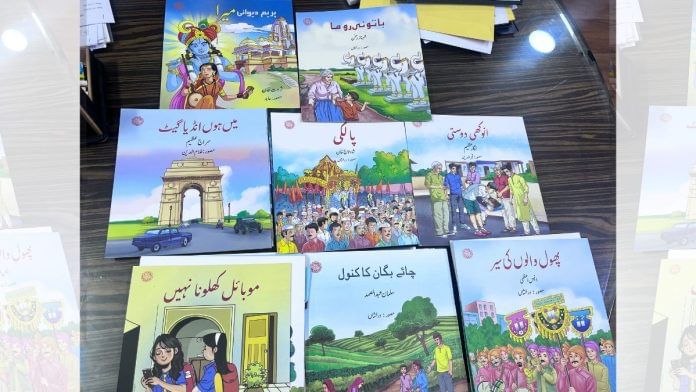New Delhi: With the aim to revive Urdu children’s literature, the National Council for Promotion of Urdu Language (NCPUL)—an autonomous body under the Union Ministry of Education—has launched an ambitious project to publish a series of illustrated books to reconnect young readers with the language.
The books feature stories rooted in Indian culture and contemporary life issues, including topics like ‘Prem Diwani Mira Bai’, the thousand-year-old Palkhi festival of Maharashtra, traditional folk dances like Lezim, and exploration of AI and robotics in schools.
The initiative aligns with the National Education Policy (NEP) 2020, which emphasises promotion of India’s cultural heritage. NCPUL will publish 56 children’s books showcasing the cultures of all states and Union Territories, 22 of which have already been released. The illustrated storybooks are meant for children of two age groups, 8-12 years and 12-18 years.
NCPUL director Dr Shams Equbal told ThePrint that there is a common perception that Urdu is largely shaped by Persian and Arabic culture, which the initiative is aimed at changing.
“For a long time, Urdu children’s literature has been dominated by stories rooted in Persian and Arabic traditions. The essence of Indian culture was missing. Our aim is to bring Urdu storytelling closer to our own soil, to reflect the lives, festivals, and heroes that children see around them,” he said.
Equbal added that in a multilingual and multicultural nation like India, it is vital that young readers see the diversity of our country represented in every language, including Urdu. “When children find their own culture and contemporary realities in these stories, they are more likely to connect with the language. That’s how we can ensure Urdu and its beautiful script remain alive, relevant, and cherished by the younger generation. We are really grateful for the support of the ministry in this initiative.”
These books are being written by prominent Urdu authors, including Sahitya Akademi awardee Zakia Mashhadi, former Vice Chancellor of Patna’s Maulana Mazharul Haq University Prof. Ejaz Ali Arshad, award-winning author Naima Jafri Pasha, renowned children’s author Mohammad Siraj Azeem, and acclaimed writer Iqbal Barki, among others.
Cultural themes
Among the books published so far are ones that explore rich cultural themes, including the tale of Mira Bai, Delhi’s famous ‘Phool Walon Ki Sair’, the life of Gautam Buddha, and Maharashtra’s Palkhi festival dedicated to the deity Vithoba. ‘Phool Walon Ki Sair’ is a historic Delhi festival celebrating communal harmony, where floral offerings are made at a mosque and a temple, accompanied by music and cultural performances.
Other titles highlight “unsung” heroes, such as Mazharul Haque—a freedom fighter and advocate of Hindu-Muslim unity—and art forms like Lezim—a vibrant folk dance from Maharashtra, known for its rhythmic movements and energetic formations.
“We hardly have Urdu books on folk dances or multicultural festivals, and there are virtually none for children. It is very important for our children to learn about all traditions and festivals, which is why we have decided to cover as many as possible through this initiative,” Equbal said.
He added that most children’s literature currently available in Urdu focuses on popular writers and poets, like Iqbal, or classic tales, such as Hatim Tai—rooted in Arabian folk hero tradition—and Alif Laila, a collection blending Middle Eastern, Persian and Indian storytelling.
“But how many children know about unsung heroes, like Mazharul Haque, who played a key role in India’s Independence, or about India’s rich cultural traditions like the Palkhi festival and folk dances? We need to tell these stories in Urdu as well. We will publish more such unsung heroes in the coming month,” he told ThePrint.
Equbal explained that Urdu children’s literature has traditionally focused on moral stories.
“In these new books, special care has been taken to awaken children’s critical and innovative thinking, rather than just teaching moral lessons. We have prepared stories that spark curiosity, highlighting Indian culture and heritage—covering topics, such as India Gate, Palkhi, Gol Ghar, and folk traditions. There are also stories about notable Indian personalities, like Mahatma Buddha, Tansen, Mira Bai, Hasrat Mohani, and Mazharul Haq that appeal to children’s intellectual curiosity,” he said.
“The council has always published books on modern scientific discoveries, and now we have also introduced excellent books for children on artificial intelligence and robotics.”
AI & robotics in Urdu children’s literature
NCPUL has published some books on contemporary topics, such as use of artificial intelligence in schools, mindful use of mobile phones and robotics, and so on.
“The books address the ethical use of AI through storytelling, and emphasise that mobile phones are not toys, teaching children to use them responsibly. This is something which has not been included in Urdu children’s literature so far,” Equbal said.
He added that the council had organised a workshop last month, inviting children in the 8–18 age group to review the draft books. “We invited children to read the drafts, and their inputs were incorporated into the final editions.”
Urdu experts have welcomed the initiative. Mohammad Kazim, professor at Delhi University’s Urdu department, told ThePrint, “It’s not that (Urdu) books on Indian festivals and culture don’t exist, but they are very few. There was also a major gap in children’s books on contemporary topics, like AI and mobile phones, in Urdu, whereas such books have been available in English and other languages for years. This initiative will make Urdu children’s literature far more appealing.”
Meanwhile, NCPUL is also planning to republish these books in bilingual formats. “The next edition will feature stories in Urdu-Hindi and Urdu-English, in line with the NEP 2020’s emphasis on a multilingual approach.”
(Edited by Mannat Chugh)






